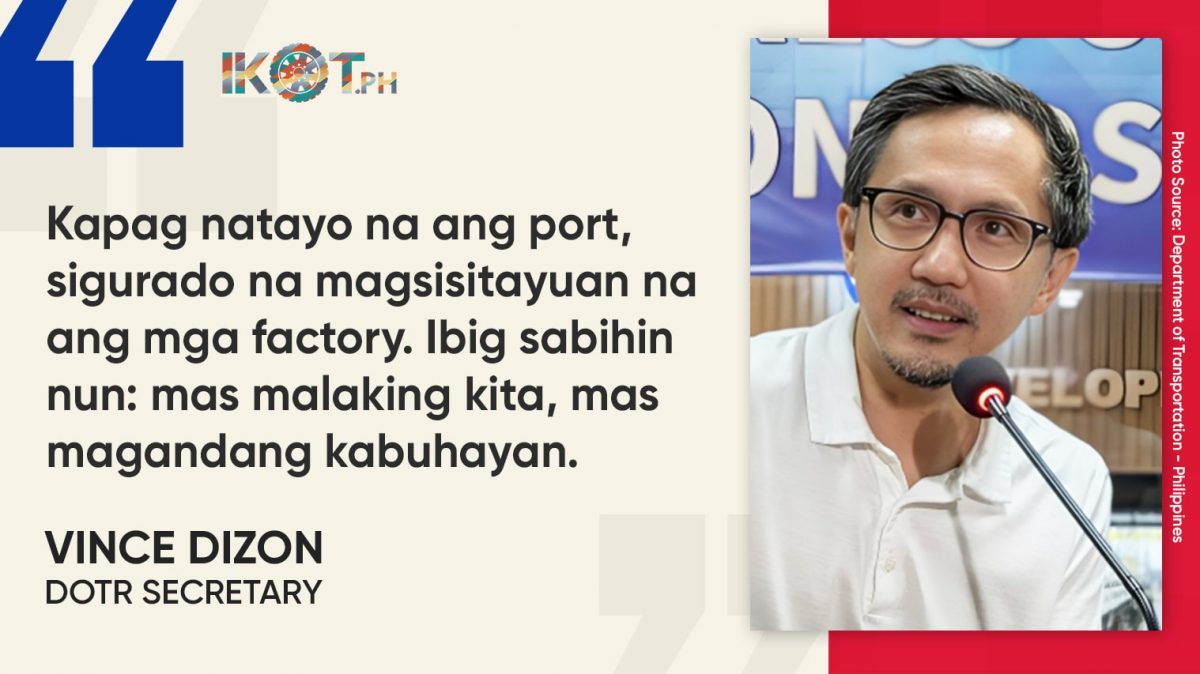Transportation Secretary Vince Dizon and Philippine Ports Authority (PPA) General Manager Jay Santiago led the inspection of the Luzon International Container Terminal (LICT) in Bauan, Batangas recently, highlighting the government’s efforts to modernize port infrastructure and drive inclusive economic growth in line with President Ferdinand Marcos Jr.’s vision of a stronger, more resilient Philippine economy.
Also joining the inspection were key officials from the local government of Bauan, who expressed full support for the development of the terminal, which is expected to create thousands of jobs and stimulate industrial expansion in the region.
The LICT involves an $800-million investment from International Container Terminal Services, Inc. (ICTSI) and is poised to become the largest privately funded marine terminal in the Philippines.
Once completed, it will be the country’s second-largest container terminal after ICTSI’s Manila International Container Terminal, significantly expanding the nation’s port capacity and reinforcing Southern Luzon’s role as a major trade and logistics hub.
In his remarks, Dizon emphasized the importance of local cooperation in pushing forward such transformative projects.
“Maraming plano na magtatayo sa tabi ng port na ito ng industrial and manufacturing parks na magbibigay ng trabaho at malaking potensyal—hindi lang sa Bauan, hindi lang sa Batangas kundi sa buong Region 4-A.”
“Nagpapasalamat tayo sa buong LGU, kinausap natin sila dahil lahat ay gusto talagang mangyari itong project na ito dahil libo-libo ang make-create nitong trabaho, lalo na nalaman natin na maraming plano na magtatayo sa tabi ng port na ito ng industrial and manufacturing parks na magbibigay ng trabaho at malaking potensyal—hindi lang sa Bauan, hindi lang sa Batangas kundi sa buong Region 4-A,” the transport chief said.
“So ang laking potensyal talaga. Pero mag-uumpisa ’yan sa port. Kapag natayo na ang port, sigurado na magsisitayuan na ang mga factory. Ibig sabihin nun: mas malaking kita, mas magandang kabuhayan para sa mga taga-Bauan lalo na,” the transport head added.
Santiago echoed this vision and highlighted the cutting-edge design of the LICT, particularly its shift toward full automation.
“Napakaganda po ng plano na gagawin ng ICTSI dito sa Luzon International Container Terminal. In fact, hindi ito ‘yung unang terminal ng ICTSI na magiging fully-automated—nauna na riyan ‘yung sa Melbourne, Australia, ‘yung Victoria International Container Terminal kung saan nakikita natin na ang mga crane ay remote-controlled, hindi kailangang may tao sa loob. Pati ang pagsundo ng mga container ay automated na rin. Hindi kailangan ng driver para masigurado ang ligtas na operasyon,” the PPA General Manager explained.
He added that shifting cargo movement to Bauan will help decongest Metro Manila ports.
“Nagpaplano na ang national government, kasama ang private partner na ICTSI, na simulan na ring ilipat ang cargo movement palabas ng Maynila papunta dito sa Southern Luzon.”
“Nakikita natin ngayon, puro sasakyan ang laman ng port. Pero ito ay magiging isang container terminal—meaning, mga boxes o container ang ilalagay dito. Bakit? Dahil sa pagtaas ng antas ng kalakalan sa ating ekonomiya. Nagpaplano na ang national government, kasama ang private partner na ICTSI, na simulan na ring ilipat ang cargo movement palabas ng Maynila papunta dito sa Southern Luzon. Kailangan natin itong itulak upang sumunod na rin ang mga manufacturing companies at lumipat dito. Kapag na-expand ang kapasidad, hindi lang Metro Manila ang makinabang kundi buong CALABARZON,” Santiago explained.
Strategically located approximately 120 kilometers south of Manila and just nine kilometers from Batangas City, the LICT will have direct access to key road networks such as Makalintal Avenue, Palico-Balayan-Batangas Road, and the Bauan-Mabini Road. Upcoming expressways connecting Cavite to Bauan are also expected to boost accessibility and maximize reach across CALABARZON, one of the country’s most dynamic economic corridors.
According to PPA data, cargo throughput in Southern Luzon climbed to 46.25 million metric tons (MT) in 2024 from 44.52 million MT in 2023, reflecting a growth of about 3.89 percent. The region accounted for 15.98 percent of the country’s total cargo volume, which reached 289.41 million MT last year.
The LICT will span 56.21 hectares and feature an 800-meter quay length, berth depths of up to 18 meters to accommodate mega-ships, eight quay cranes, 20 rail-mounted gantries, and an annual handling capacity of over two million twenty-foot equivalent units (TEUs). It will also incorporate advanced automation and eco-friendly technologies to ensure efficient, sustainable operations.
Construction is set to begin in the third quarter of 2025. The target completion for the first phase by the end of 2027, with full terminal operations expected by 2028.
Dizon emphasized that the LICT reflects the Marcos administration’s commitment to building world-class infrastructure that drives growth and creates meaningful opportunities for Filipinos.
Once operational, the Luzon International Container Terminal is expected to position Southern Luzon as a premier gateway for international trade, attract new shipping lines, and solidify the Philippines’ role in the global supply chain.



